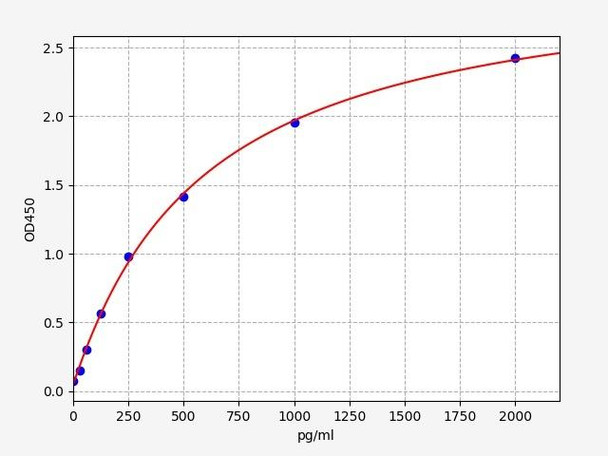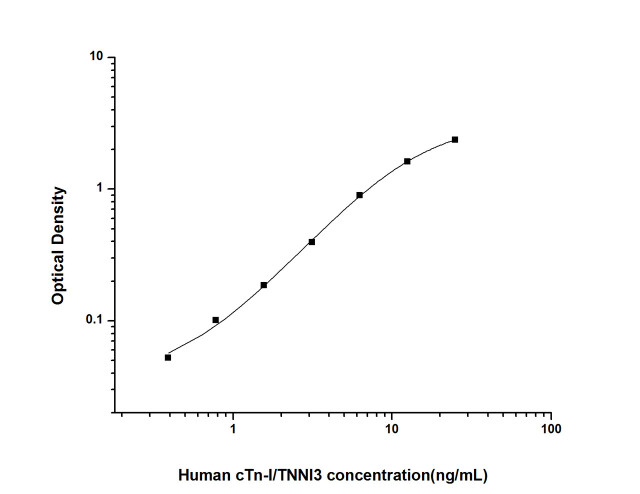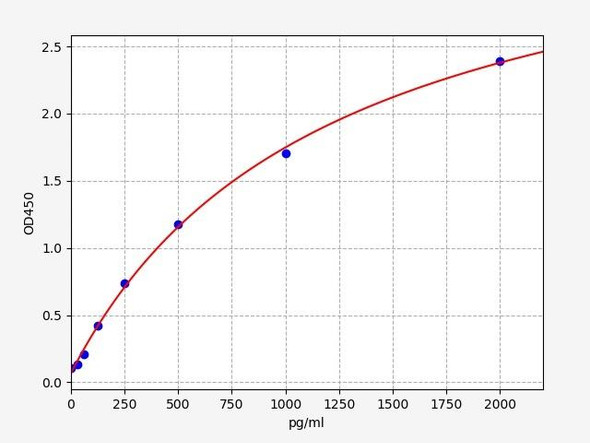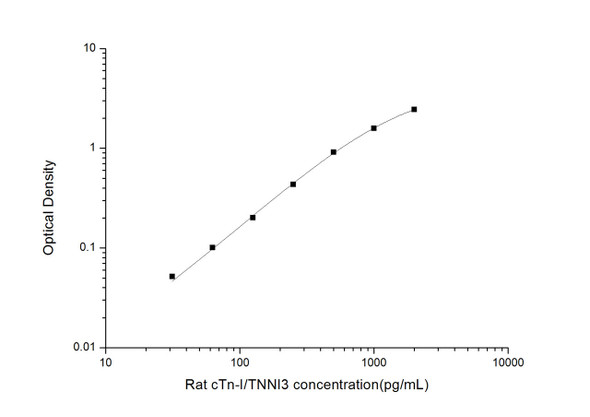Description
Monkey cTn-I / TNNI3 / cardiac Troponin I ELISA Kit
cTnI is a protein specifically found in cardiac muscle tissue. It inhibits the interaction between actin and myosin, preventing muscle contraction when the heart is at rest. During heart muscle injury or damage, such as in a heart attack, cTnI is released into the bloodstream. Elevated levels of cTnI in blood samples serve as a sensitive and specific marker of cardiac injury. The Monkey cTn-I ELISA kit is specifically designed to quantitatively measure the levels of cardiac troponin I (cTn-I) in monkey samples. It serves as a valuable research tool for studying cardiac function, injury, and related conditions in monkeys.
Key Features
| Save Time | Pre-coated 96 well plate | |
| Quick Start | Kit includes all necessary reagents | |
| Publication Ready | Reproducible and reliable results |
Overview
| Product Name: | Monkey cTn-I/TNNI3 (cardiac Troponin I) ELISA Kit |
| Product Code: | MKFI00018 |
| Size: | 96 Assays |
| Alias: | cTn-I, TNNI3, cTnI |
| Detection Method: | Sandwich ELISA, Double Antibody |
| Reactivity: | Monkey |
| Sensitivity: | 18.75pg/ml |
| Range: | 31.25-2000pg/ml |
| Storage: | 4°C for 6 months |
| Note: | For Research Use Only |
Additional Information
| Intra-Assay: | |
| Recovery | Matrices listed below were spiked with certain level of Monkey cTn-I/TNNI3 and the recovery rates were calculated by comparing the measured value to the expected amount of Monkey cTn-I/TNNI3 in samples. Please contact us for more information. |
| Linearity: | The linearity of the kit was assayed by testing samples spiked with appropriate concentration of Monkey cTn-I/TNNI3 and their serial dilutions. The results were demonstrated by the percentage of calculated concentration to the expected. Please get in contact for more information.Please get in contact for more information. |
| CV (%): | Intra-Assay: <8 Inter-Assay: <10 |
Kit Components
| Component | Quantity | Storage2-8°C |
| ELISA Microplate (Dismountable) | 8x12 strips | 2-8°C/-20°C |
| Lyophilized Standard | 2 | 2-8°C/-20°C |
| Sample/Standard Dlution Buffer | 20ml | 2-8°C |
| Biotin-labeled Antibody (Concentrated) | 120ul | 2-8°C (Protection from light) |
| Antibody Dilution Buffer | 10ml | 2-8°C |
| HRP-Streptavidin Conjugate (SABC) | 120ul | 2-8°C (Protect from light) |
| SABC Dilution Buffer | 10ml | 2-8°C |
| TMB Substrate | 10ml | 2-8°C(Protection from light) |
| Stop Solution | 10ml | 2-8°C |
| Wash Buffer (25X) | 30ml | 2-8°C |
| Plate Sealer | 5 | - |
Other materials required:
- Microplate reader with 450 nm wavelength filter
- Multichannel Pipette, Pipette, microcentrifuge tubes and disposable pipette tips
- Incubator
- Deionized or distilled water
- Absorbent paper
- Buffer resevoir
Protocol
*Note: Protocols are specific to each batch/lot. For the exact instructions please follow the protocol included in your kit.
Before adding to wells, equilibrate the SABC working solution and TMB substrate for at least 30 min at 37°C. When diluting samples and reagents, they must be mixed completely and evenly. It is recommended to plot a standard curve for each test.
| Step | Procedure |
| 1. | Set standard, test sample and control (zero) wells on the pre-coated plate respectively, and then, record their positions. It is recommended to measure each standard and sample in duplicate. Wash plate 2 times before adding standard, sample and control (zero) wells! |
| 2. | Aliquot 0.1ml standard solutions into the standard wells. |
| 3. | Add 0.1 ml of Sample / Standard dilution buffer into the control (zero) well. |
| 4. | Add 0.1 ml of properly diluted sample ( Human serum, plasma, tissue homogenates and other biological fluids.) into test sample wells. |
| 5. | Seal the plate with a cover and incubate at 37 °C for 90 min. |
| 6. | Remove the cover and discard the plate content, clap the plate on the absorbent filter papers or other absorbent material. Do NOT let the wells completely dry at any time. Wash plate X2. |
| 7. | Add 0.1 ml of Biotin- detection antibody working solution into the above wells (standard, test sample & zero wells). Add the solution at the bottom of each well without touching the side wall. |
| 8. | Seal the plate with a cover and incubate at 37°C for 60 min. |
| 9. | Remove the cover, and wash plate 3 times with Wash buffer. Let wash buffer rest in wells for 1 min between each wash. |
| 10. | Add 0.1 ml of SABC working solution into each well, cover the plate and incubate at 37°C for 30 min. |
| 11. | Remove the cover and wash plate 5 times with Wash buffer, and each time let the wash buffer stay in the wells for 1-2 min. |
| 12. | Add 90 µl of TMB substrate into each well, cover the plate and incubate at 37°C in dark within 10-20 min. (Note: This incubation time is for reference use only, the optimal time should be determined by end user.) And the shades of blue can be seen in the first 3-4 wells (with most concentrated standard solutions), the other wells show no obvious color. |
| 13. | Add 50 µl of Stop solution into each well and mix thoroughly. The color changes into yellow immediately. |
| 14. | Read the O.D. absorbance at 450 nm in a microplate reader immediately after adding the stop solution. |
Sample Type
When carrying out an ELISA assay it is important to prepare your samples in order to achieve the best possible results. Below we have a list of procedures for the preparation of samples for different sample types.
| Sample Type | Protocol |
| Serum | If using serum separator tubes, allow samples to clot for 30 minutes at room temperature. Centrifuge for 10 minutes at 1,000x g. Collect the serum fraction and assay promptly or aliquot and store the samples at -80°C. Avoid multiple freeze-thaw cycles. If serum separator tubes are not being used, allow samples to clot overnight at 2-8°C. Centrifuge for 10 minutes at 1,000x g. Remove serum and assay promptly or aliquot and store the samples at -80°C. Avoid multiple freeze-thaw cycles. |
| Plasma | Collect plasma using EDTA or heparin as an anticoagulant. Centrifuge samples at 4°C for 15 mins at 1000 × g within 30 mins of collection. Collect the plasma fraction and assay promptly or aliquot and store the samples at -80°C. Avoid multiple freeze-thaw cycles. Note: Over haemolysed samples are not suitable for use with this kit. |
| Urine & Cerebrospinal Fluid | Collect the urine (mid-stream) in a sterile container, centrifuge for 20 mins at 2000-3000 rpm. Remove supernatant and assay immediately. If any precipitation is detected, repeat the centrifugation step. A similar protocol can be used for cerebrospinal fluid. |
| Cell culture supernatant | Collect the cell culture media by pipette, followed by centrifugation at 4°C for 20 mins at 1500 rpm. Collect the clear supernatant and assay immediately. |
| Cell lysates | Solubilize cells in lysis buffer and allow to sit on ice for 30 minutes. Centrifuge tubes at 14,000 x g for 5 minutes to remove insoluble material. Aliquot the supernatant into a new tube and discard the remaining whole cell extract. Quantify total protein concentration using a total protein assay. Assay immediately or aliquot and store at ≤ -20 °C. |
| Tissue homogenates | The preparation of tissue homogenates will vary depending upon tissue type. Rinse tissue with 1X PBS to remove excess blood & homogenize in 20ml of 1X PBS (including protease inhibitors) and store overnight at ≤ -20°C. Two freeze-thaw cycles are required to break the cell membranes. To further disrupt the cell membranes you can sonicate the samples. Centrifuge homogenates for 5 mins at 5000xg. Remove the supernatant and assay immediately or aliquot and store at -20°C or -80°C. |
| Tissue lysates | Rinse tissue with PBS, cut into 1-2 mm pieces, and homogenize with a tissue homogenizer in PBS. Add an equal volume of RIPA buffer containing protease inhibitors and lyse tissues at room temperature for 30 minutes with gentle agitation. Centrifuge to remove debris. Quantify total protein concentration using a total protein assay. Assay immediately or aliquot and store at ≤ -20 °C |
| Breast Milk | Collect milk samples and centrifuge at 10,000 x g for 60 min at 4°C. Aliquot the supernatant and assay. For long term use, store samples at -80°C. Minimize freeze/thaw cycles. |
Cardiac Troponin I Background
Cardiac Troponins
Cardiac troponins are a group of proteins found in cardiac muscle (myocardium). They play a vital role in regulating the contraction and relaxation of cardiac muscle fibers, which is essential for normal heart function. The cardiac troponin complex consists of three subunits: troponin I (cTnI), troponin T (cTnT), and troponin C (cTnC).
Cardiac Troponin I
Cardiac troponin I (cTnI) is a protein primarily found in cardiac muscle tissue. It is one of the three subunits of the troponin complex, along with troponin T (cTnT) and troponin C (cTnC). These proteins play a crucial role in regulating muscle contraction in the heart.
Cardiac Troponin I Function
The primary function of cardiac troponin I (cTnI) is to regulate the contraction and relaxation of cardiac muscle fibers. It plays a crucial role in the process of cardiac muscle contraction by inhibiting the interaction between actin and myosin, two proteins involved in muscle contraction.
When the heart is at rest, cTnI binds to actin, preventing the interaction between actin and myosin. This inhibitory action keeps the cardiac muscle relaxed and prevents contraction. When the heart receives signals to contract, such as electrical impulses from the sinoatrial node (the heart's natural pacemaker), calcium ions (Ca2+) are released within the muscle cells.
The presence of calcium ions triggers a conformational change in cTnI, causing it to detach from actin. This allows actin and myosin to interact and generate the force necessary for muscle contraction. As the contraction occurs, cTnI helps regulate the duration and strength of the contraction by reattaching to actin when calcium ions are removed, leading to muscle relaxation.
The precise control of cTnI over actin-myosin interaction ensures the proper coordination and efficient contraction of cardiac muscle, enabling the heart to pump blood effectively.
TNNI3 Gene and related disorders
Located in chromosome 19, The TNNI3 gene codes for the cardiac troponin I protein, which is found solely in the heart (cardiac) muscle. Genetic mutations in this gene have been associated with familial hypertrophic cardiomyopathy (thickening of cardiac muscle), familial restrictive cardiomyopathy (stiffening of heart muscle) and Familial dilated cardiomyopathy (weakened and enlarged heart).
Cardiac Troponin I levels - pathology
Heart muscle cell damage resulting from cardiac conditions like myocardial infarction (heart attack) compromises the integrity of the cell membrane, causing the release of cardiac troponin I (cTnI) into the bloodstream. Consequently, elevated levels of cTnI in the blood serve as a specific and sensitive biomarker for diagnosing myocardial injury.
In clinical practice, healthcare professionals routinely employ cardiac troponin I measurements to evaluate patients suspected of having acute coronary syndrome (ACS) or other cardiac conditions. Monitoring the temporal profile of cTnI levels, characterized by an initial rise followed by subsequent decline, provides valuable information regarding the extent of heart muscle damage and the patient's prognosis.
Monkey cTn-I ELISA Kit FAQ
Q: What is the purpose of the Monkey cTn-I ELISA kit?
The Monkey cTn-I ELISA kit is specifically designed to quantitatively measure the levels of cardiac troponin I (cTn-I) in monkey samples. It serves as a valuable research tool for studying cardiac function, injury, and related conditions in monkeys. By accurately measuring cTn-I levels, researchers can gain insights into cardiac diseases, drug interventions, and the mechanisms underlying cardiac pathologies in monkey models.
Q: What type of samples can be used with the Monkey cTn-I ELISA kit?
The Monkey cTn-I ELISA kit is suitable for biological fluids such as serum samples
Q. Can this kit be used for clinical diagnostics?
No, this kit is designed for research purposes only and is not intended for clinical diagnostic use. It should not be used for patient diagnosis, treatment decisions, or management of cardiac conditions in a clinical setting
Q: Can this kit be used for other species or sample types?
While this kit is specifically validated for monkey samples, it may also be suitable for other non-human primate species. However, it is essential to validate the kit's performance for different species or sample types through appropriate pilot experiments and comparisons to ensure reliable results.
Q: Where can I find additional technical support or assistance with the kit?
For any technical inquiries or assistance regarding the Monkey cTn-I kit, you can reach out to our team. They will be available to answer your questions and provide the necessary guidance to ensure a successful experiment.
Related Products
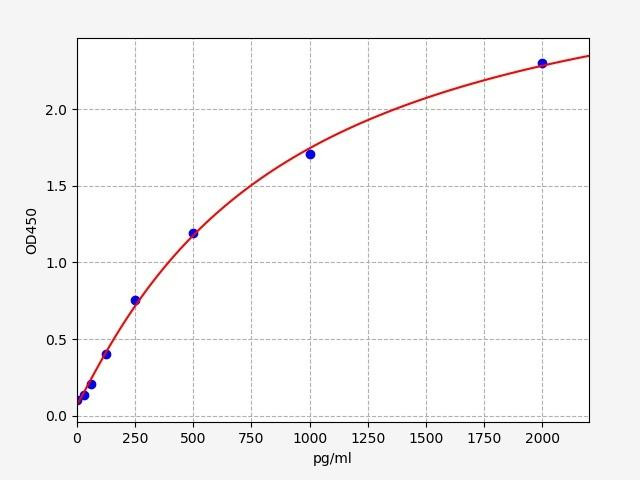
| Human TNNC2 ELISA Kit | |
|---|---|
| ELISA TYPE: | Sandwich ELISA, Double Antibody |
| SENSITIVITY: | 18.75pg/ml |
| RANGE: | 31.25-2000pg/ml |
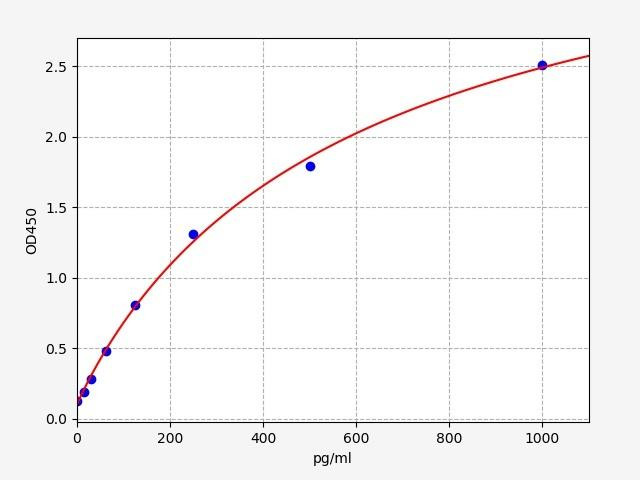
| Human Troponin T, fast skeletal muscle ELISA | |
|---|---|
| ELISA TYPE: | Sandwich ELISA, Double Antibody |
| SENSITIVITY: | 9.375pg/ml |
| RANGE: | 15.625-1000pg/ml |

